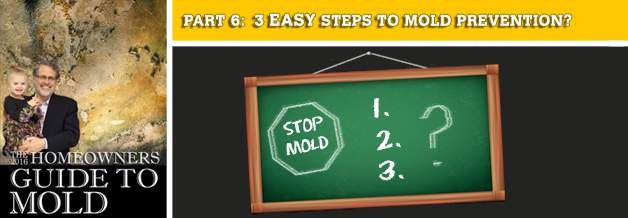The 2016 Homeowners Guide to Mold – Part 6
1- Control humidity
Condensation from high relative humidity is responsible for more mold growth than anything else. This is easily fixed by using a properly functioning HVAC and the exhaust systems in your home (bathroom fans and kitchen exhaust hood.) Sometimes we find that although these systems are available, they aren’t being used in the way they were intended.
Do you close the vents in your basement to get more air upstairs? Don’t! This will prevent the basement air from being circulated and allow humidity to rise.
Do you shut off your HVAC to save electricity? Don’t! Saving $20 a month on the power isn’t worth a thousand dollar mold problem.
Have you put off having your HVAC serviced? Don’t! This can prolong the life of the components, prevent leaks and ensure that the HVAC is operating at peak efficiency.
2- Keep your basement dry
Most homes on the east coast are built either on a crawlspace or a basement – both of which may be damp because of the high water table and poorly drained soil. Sump pumps can help keep excess water out, but the best thing for your basement is to keep surface water away from your foundation.
➢ Downspouts and sump pump discharge at least 10 feet from the foundation
➢ The soil around the home should be graded so that water flows away from the foundation
➢ Gutters must be the proper size and kept free of leaves and debris
➢ Outside drains should be inspected regularly and cleaned to prevent clogging
These simple steps can prevent most basement moisture issues, can save you thousands of dollars in basement waterproofing, and prevent mold.
3- Take care of water losses quickly and correctly
If you have wet material in your home you need to get it dry before mold starts to grow. Remember, mold spores are everywhere and we build our homes out of cellulose, so moisture is the only missing ingredient. Calling a professional company to assess what is wet (which may not always be obvious without using sophisticated meters), and developing a strategy to dry it out can allow you to salvage much, if not all, of the damaged material. Have a loss not covered by your insurance or a high deductible? No problem, work with a firm directly to help get things dry. Here’s a little-known fact you most people don’t know: Insurance companies require a lot of paperwork to process a claim and can slow the process down. Working directly with a quality restoration company may actually save you time and money. You can always wait until everything is finished before determining whether or not to file a claim, just save your receipts.
Part 2: Why mold is more dangerous today?
Part 3: Why it is critical to act now?
Part 4: Mold Removal: WHEN CAN I DIY?
Part 5: Selling your home – what will the buyer say?













